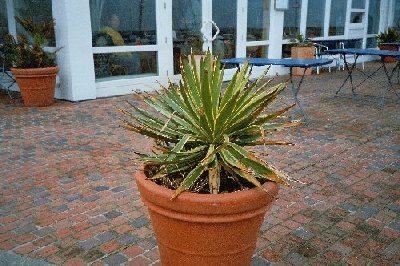
Inspection Round October 2004
The first inspection round on the island has brought a quantity of important cognitions which also would be scientific and botanic of importance.
By the Halunderjet I went comfortable with my wife to Heligoland.
Mattered on Heligoland I discovered 4 Chamaerops humilis and 4 Furcraea longaeva 'Variegata' at the ferry house "Marina" in the south port in terrakotta pots. The leaves were partly damaged, the frost is not to blame. But the strong sea salt wind. But they are quite adaptable.

Furcraea longaeva 'Variegata' in terrakotta pots at the ferry house "Marina"
in October 2004
Ulf Martens came to pick us up and took the citrus trees, khaki trees, rhododendrons and ornamental grasses in reception which I brought. I had nothing else than left to bring them to Heligoland earlier since my greenhouse was already too full to take all plants for the overwintering.
We passed by the hotel "Insulaner", I saw the most famous Jubaea chilensis of the island which we had planted in May 2004. The Jubaea still looked quite good, but few new growth. Obviously the summer 2004 had been a little too cold despite sufficient precipitations, cooler than normal It also hadn't been different on the mainland. To this still, the palm still must root in and establish, then will take off with the growth right.
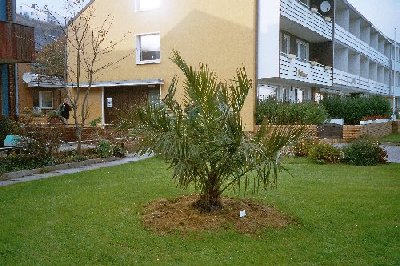
Jubaea chilensis at the hotel "Insulaner" in October 2004
We went onto the Upper Land and were quartered at Mrs. Martens, the mother of Ulf in the "Monika" House. We then went with Ulf and the plants to James Kruess School. I saw some scions of Yucca recurvifolia and asked Ulf whether they are from Bernhard Janisch. He denied and said he has brought these from Emsland from the vacation.
Unfortunately, Ulf had no time that he surprisely had visit, therefore we arranged an appointment for an inspection round for the next day at 10.00 a. m. in the atria of the James Kruess School. But I was very short in the atria and also saw that the results are different, I could state near only the next day.
However, I noticed that Pittosporum tobira, Nerium oleander, Quercus suber, Viburnum tinus, Araucaria heterophylla, Cycas revoluta, Pinus halepensis, Butia capitata, Trachycarpus wagnerianus and also Trachycarpus fortunei from the Mielck House are grown well, when the locations aren't so extremely windy. It is astonishing that Pittosporum tobira, Viburnum tinus and Quercus suber have been able to manage well and were grown also well at the quite windy location on the school playground on the planting island. Even the two Viburnum tinus attached have flower buds. Against this Nothofagus procera has big problems at the school playground, so it has to be classified as not wind resistant and salt tolerant, while Nothofagus dombeyi is suitable a little better only at locations sheltered from the wind.
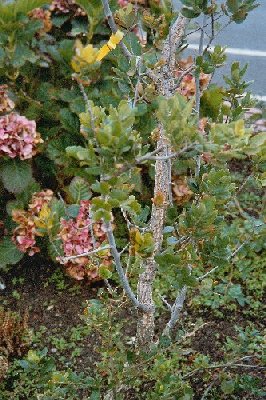
Intact foliage of Quercus suber in October 2004
I also noticed that Pinus pinea and canariensis aren't very salt wind tolerant, against this Araucaria araucana and heterophylla are more salt wind tolerant and show no damages and grow on Heligoland very well. It is recommendable to grow araucarias on Heligoland. As the next araucaria species Araucaria angustifolia will come onto the island to put its suitability for Heligoland in comparison with the two other species under proof. I have successfully grown several seedlings from seed, they shall come onto the island in 2006.
Then I have put my straight brought plants down in the atrium 2 for the outplantations on the following day.
We went to the "Monika" House once again and put my rolling bag down there. And approached the northeast area down to the swimming pool to go to the swimming pool trachy. The Trachycarpus wagnerianus with its beautiful furry trunk looked very good and has come on very well and grown equally very well, the location is relatively sheltered from the wind.
Then we went to the Mielck House to see the after the plants on the newly planted bed in the inner courtyard. I saw also to the replanted trachy at the wall, it still was grown also well and lives, will take off right well only in the next year again. One can successfully replant trachies. However, it has to be taken into account that they should have a root bale as good as possible, good regrowing chances are given only in such a way. However, it is a luck that the last summer 2004 was so precipitation rich. I rang at the door of Dr. Wiltshire and she was fortunately there. She unlocked the Mielck House so that we got access to the inner courtyard. I went into the inner courtyard and noticed that the plants were grown very well and were in the best condition. Even Delosperma cooperi and the opuntias were grown very well. And Delosperma cooperi also has spread well and flourished. The Yucca aloifolia, Olea europaea, Cylindropuntia imbricata and Nerium oleanders 'Atlas' also were grown very well and look fine. I also told this to Dr. Wiltshire, she also was happy. This place is really ideal and well protected!
On the way to the hotel "Atoll" we visited Mrs. Hartmann and her Canary fruit banana Musa 'Dwarf Cavendish'. The banana in the tropical corner of the read hall is grown up to a de luxe specimen! A smaller second banana stands besides it, this one Ruth Hartmann had bought in a supermarket. At first I thought it is already a pup of the large read hall banana.
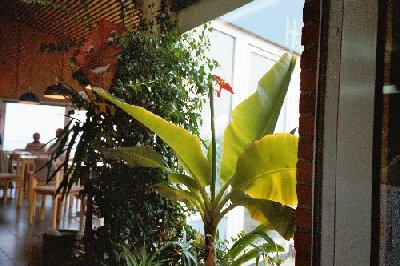
Musa 'Dwarf Cavendish' in the read hall of the Heligolandian library in
Oktober 2004
We went to the hotel "Atoll" and saw after the palms, oleander and bamboos. The Trachycarpus wagnerianus looked not quite so good, has difficulties in claiming itself there. The two oleanders and Chamaerops humilis also showed foliage damages. Obviously the location is too windy. Trachycarpus wagnerianus isn't as very wind tolerantly as expected, it can have problems at too strong windy places, is only a little wind toleranter than Trachycarpus fortunei, the salt tolerance is like the of Trachycarpus fortunei. Conspicuous is the difference at the two Chamaerops humilis. The softer and larger variety of Manfred Nold is substantially more damaged than the stout and stiffer smaller variety from BAUHAUS in Hamburg, this one is more salt wind tolerant. It seems so that there are more and less salt wind tolerant varieties and origins of Chamaerops humilis.
I also saw to Washingtonia filifera and Pleioblastus simonii, looked already better than her "colleagues" at the elevator tower of the hotel "Atoll" since sheltered from the wind.
I noticed also that even Buxus sempervirens in terrakotta pots at the elevator tower have the same damages as the palms, oleander and bamboo at the elevator tower and the pillars. Not the winter hardiness is to blame for the damages but only the salty strong sea wind! On the other hand, the Buxus sempervirens in pots in the inner courtyard between city hall and hotel "Atoll" looked still good, a sign that this inner courtyard also would be more suitable for palm planting. The inner courtyard could be altered and be planted with palms at the given time, probably with Jubaea chilensis, Butia capitata, Chamaerops humilis or even Phoenix canariensis.
For my surprise I discovered in the neighborhood of the city hall under a big tree one planted personally by Heligolandians Nerium oleander (well with white simple flowers) in very good condition and also two Callistemon laevis (I found even a label with the botanic name), Cyperus alternifolius and a white flowering unknown Hebe species. We will keep these also in the eye and watch. Our project could slowly win at momentum. Within some years our project could become independent as far as so that the Heligolandians discover their love for "exotics" and palms and develop self-initiatives.
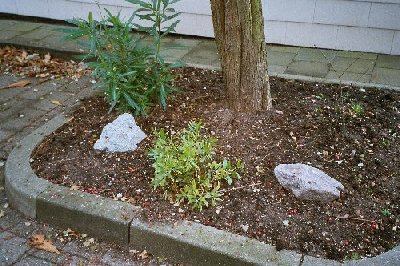
O
ne self-initiative of the Heligolandians to plant "exotics" out! HereNerium oleander and Callistemon laevis in October 2004.
Cordyline australis also has grown well last summer 2004, seems to be quite easy on Heligoland, but we will keep this species in the eye.
We went to the reception of the hotel "Atoll" and wanted to talk to Mr. Cantauw. The woman at the reception asked whether I would like to pass on to him. She told me that Mr. Cantauw would be there toward noon on Saturday.
Then we went to the hotel "Insulaner". I went to the reception and asked for Detlev Rickmers. However, I learned that he wasn't here. I asked there whether I may look at the garden. Yes, I was allowed to look at the garden and to check the "exotics" and palms, most of all are well!
I also noticed that Butia capitata from Manfred Nold looked very good without problems and relative salt wind tolerant. Even Arbutus unedo flourished much and didn't show any trace of salt wind damages, prospers on Heligoland very well! Much more should be planted on Heligoland! Ulf shall get a couple of Arbutus unedo soon, too. I notice at 'Carrizo Citrange' that the leaves didn't show no salt wind damages, a sign for a good salt wind tolerance at wind sheltered places, while the other bushes in a close neighborhood were showing clear salt wind damages on their leaves.
Also Opuntia sp., Agave americana marginata and Aloe striatula were grown well. The olive looked good, but was grown only few, although the same species showed in the inner courtyard of the Mielck House and in an atrium of the James Kruess School much more new growth. Olives prosper on Heligoland very well and more should be planted on the island if they come through the coming winter 2004/05 well. Olea europaea also has proved to be sea salt wind tolerant.
Pinus canariensis also showed salt wind damage, protected by bushes less than in the atria of the James Kruess School, there, however. Unfortunately, Musa basjoo 'Sapporo' showed a disappointment, instead of which expected size of at least 5 to 8 feet only approx. 2 feet tall, new leaves were grown also but windswept. Obviously the summer 2004 was not so good, a little too cold. Mine in my garden in Hamburg also are retarded a little but much larger, not more than 8 feet of size, approximately the size of a Canary banana on Tenerife. Bananas are rather thermophil. Whether the Musa basjoo 'Sapporo' survives the winter 2004/05 at this unexpectedly low size on Heligoland? We want to hope that the winter 2004/05 gets as mild as 2003/04 there on Heligoland with similar minimum temperatures. Whether bananas will bear fruit at these summer conditions like 2004 on Heligoland one day, still be in the stars.
There Citrus fruits seem to have the better cards than the bananas on Heligoland there, see 'Carrizo Citrange'. Also yuccas, Chamaerops humilis (stout stiff leaved variants) and cactuses, also olives and strawberry trees have good chances to get ready with the quite windy but mild Heligoland's high maritime climate.
However, it is clear that Musa basjoo and its hardy banana colleagues require a sunny, warm location very well sheltered from the wind where they could become more than 7 to 10 feet tall after warm summers.
The summer conditions for bananas are just less favorable on Heligoland than on the mainland, but the other way round the winter conditions on Heligoland have are better than on the mainland.
The bamboos also have grown but also weak. They have to etablish, then they will take off right.
Suprisely I stated that one of the two Phoenix canariensis has recovered again and has showed a quantity of new feather leaves. It already stands year-roundly without winter protection for years outdoors. The chances for Phoenix canariensis on Heligoland aren't that bad at all. Some additional specimens could be planted planted next year if these at the hotel "Insulaner" and in school have come through the winter 2004/05 well. Perhaps we will try larger specimens.
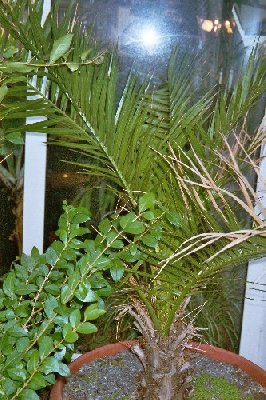
Phoenix canariensis (still) in the pot since years
outdoors, has surprisely recovered from the dry
damages well again!
The next day at the breakfast I spoke with Ulfs' mother whether she would be ready to have planted also trachys and other "exotics" into her garden and also offered her my trachys from Reto Gamma from Brissago/Ticino from my greenhouse. She told me that her son would like to plant palms and other "exotics" into his garden.
We went after the breakfast with Mrs. Martens to school. I made controls in the atria and also made photos.
The trachys also were grown, I also saw the second trachy of the Mielck House, it was grown well. Ulf has planted several privets as wind protection in the atria. Phormium tenax and Olea europaea also have proved here suitable for Heligoland. Phormium tenax is grown on Heligoland very well and also seems to be sea salt wind tolerant, like also Olea europaea, Querecus suber, Pinus halepensis, Cordyline australis, Camelia japonica, ‚Carrizo Citrange’, ‚Swingle Citromelo’, Araucaria araucana and heterophylla, Cycas revoluta, Arbutus unedo, probably also Araucaria angustifolia, Arundo donax, Cupressus macrocarpa, Callistemon citrinus, Delosperma cooperi, Viburnum tinus, Yucca recurvifolia and other different yucca species, also different opuntia and aloe species.
As some wind shelter needing and medium sea salt wind tolerant have proved: Butia capitata, Jubaea chilensis, Washingtonia filifera and robusta, Phoenix canariensis, Trachycarpus species, different Phyllostachys species, other bamboo species, eucalyptus species, Musella lasiocarpa, cistus species, Cupressus arizonica, Cupressus sempervirens, Rhododendron arboreum, falconeri, hodgsonii, macabeanum, Cordyline australis atropurpureum, Cinnamomum japonica, Sabal minor, Nerium oleander, Livistona australis.
Unfortunately, there also were failures and storm damages. Citrus unshiu lost the total foliage, but it was full of still unripen fruits, the shoots are still green. Acacia rubida and riceana have proved as not sea salt wind tolerant and died. The Acacia dealbata still lives but lost all of their leaves, on the other hand it kept in the garden of the hotel "Insulaner" better, still partly leaved. Acacia species with fine feather leaves aren't wind tolerant enough for Heligoland. But the genera Acacia has so many species, there are also to find sea salt wind tolerant and simultaneous hardy species, perhaps are phyllocladia species like Acacia pravissima, reticulata and longifolia better. Acacia alpina is the hardiest species with phyllocladies (firm adult leaves, typical are for that the willowlike leaves), but difficult to get, seems to be rare. Unfortunately, the storm has fold Eucalyptus niphophila, the trunk shows new growths. Stout and well branched specimens of Eucalyptus niphophila and pauciflora might be well suitable for Heligoland.
Eucalyptus gunnii has proved as not particularly salt wind tolerant, salt wind damages at the foliage were to see, in the garden of the hotel "Insulaner" and in school at the same time. There must be also similarly sea salt wind tolerant and frost hardy species, primarily Eucalyptus niphophila and pauciflora would be possible for this.
Differences are clear in the sea salt wind tolerance also at the two Cycas species. Cycas circinalis showed leaf spots and sea salt wind damage, on the other hand Cycas revoluta is sea salt wind tolerant!
Ulf also has planted a Cordyline australis, a quite big specimen, the storm has destroyed it unfortunately, the trunk was too thin according to Ulf. He has put the broken large piece into the water and he hopes that it will root. But next year we will try get several specimens of Cordyline australis which are smaller and leaved from the ground, they might be less problematic, this I told Mr. Martens.
Surprisely Ulf also has planted one Magnolia stellata in one atrium of school. Also some outplantations I made together with Mr. Martens. The three Carex trifida from New Zealand (requires winter protection on the mainland) were planted to Phormium tenax. 'Rusk Citrange', 'Citrandarin polyembryonic', 'Russian Citrange' and the both Diospryos kaki were planted to the sheltered places closed to the wall in the atrium 2 with my new experiences. Also the both Rhododendron cinnabarinum were planted to the other rhododendrons and camelias out. The growing chances for fall plantations on Heligoland are better than on the mainland if one oversummers and toughens up "exotics" in the nursery before that, and it's seldom colder than 23°F and continuous frost periods without snow cover are very rare on Heligloand.
Unfortunately, the bananas didn't get big, but Musa basjoo in the atrium 1 at the greenhouse next to 'Swingle Citromelo' kept best. The banana at the greenhouse is grown well and got one pup, but still under 4 feet, but larger than Musa basjoo 'Saporro' in the garden of the hotel "Insulaner". Musella lasiocarpa proven as right wind tolerant, see whether it will survive the coming winter. Musa thomsonii behind of the greenhouse next to Eucalyptus gunnii and Cupressus cashmeriana has kept its foliage completely as also the Musa basjoo in the front of the greenhouse next to 'Swingle Citromelo', strongly but in the growth remained back like also my former outplanted Musa thomsonii in Hamburg, the both I have dug up and potted again, are now standing in my livingroom to overwinter, obviously still too small to overwinter with winter protection outdoors. Only mature specimens which are tall than 8 feet and have already pups and one partly woody corm will overwinter outdoors under winter protection (very thick mulch cover of dry leaves and straw in one large box with rain protection roof) successfully.
That the bananas have considerably stayed behind in the growth was due to the last summer 2004 which was much cooler than the summer 2003, the summer 2004 was just far too cool for the season, June and July were too cold, the August better, therefore sub-average. Added to that the frequent storms and thunderstorms which are too freguent in the comparsion. All of that the summer 2004 was too windy and too cold, but the precipitations were sufficient.
But Ulf also has two Musa 'Dwarf Cavendish' in pots in the walk at the atrium 4. 'Dwarf Cavendish' is the famous Canary banana which is known because of the little sweet and aromatic fruits and the famous Canary banana liqueur which is offered in cluster formed bottles on the Canary Islands.
When the biology teacher of the school goes in pension, the corner at the greenhouse could become free and could be planted with Musa basjoo, cheesmani, sikkimensis 'Red Tiger' and nagensium if I do have success in growing from seed. This place is better suitable for bananas because much more sheltered from the wind than most previous test locations for bananas on Heligoland.
Also Ensete glaucum is wind-proofer than the musas. It is now proved that Ensete and Musella have wind solider leaves than Musa. That Musella lasiocarpa has wind solider leaves, lies that the species is from the mountain regions of Yunnan. Just in the mountains regions it is often windy, in higher situations primarily similarly like on the islands and in the coastal regions. This can be explained the wind strength of Ensete and Musella.
The bananas in the atrium 2 have lost their whole leaves through the storms of the last weeks, only the naked pseudotrunks are been left. Whether they come next year again? If they survive and sprout again and the corner in the atrium 1 is cleared up by the retirement of the biology teacher, they will replanted into the corner.
Also in the atrium 4 some opuntias and Cylindropuntia imbricata still are at the life, also Yucca elephantipes and recurvifolia. A Passiflora caerulea has actually formed a fruit of the size of a golf ball although the almost whole leaves was gone due by wind. Helix and Passiflora have the same problems with the wind, therefore the Helix also has difficulties with establishing, therefore many failures. Helix and Passiflora can thrive without problems on Heligoland only at places well sheltered from the wind. Replantations also are planned but at other places therefore at places sheltered from the wind at the wind protection shrubs.
In the atrium 2 also were an Agave americana and Yucca gloriosa x recurvifolia from Bernhard Janisch planted by Ulf out. Whether the Agave americana will survive, it will be seen in winter 2004/05. The Agave americana marginata in the garden of the hotel "Insulaner" still looked very good and is also grown well. This shows that Agave americana could be suitable for Heligoland if it were more wetness tolerant at frost.
In the half atrium the bamboos still look very good, were grown well. Later, if the bamboo has itself established once and many runners have formed, the rampant grass could be forced back by nature, this I said to Ulf.
In the noon we still went to the hotel "Atoll" after we have said goodbye to Ulf and collected our baggage from his mother. At first Mr Cantauw wasn't here, one told us he would be there toward 2 p.m. Therefore we went out to a restaurant to have lunch, then we were still waited in the entrance hall of the hotel "Atoll" until Mr Cantauw was there. I reported to Mr. Cantauw about my inspection rounds and my experiences. And asked him for redesign plans in the surroundings of the hotel and the city hall. He said one also makes thoughts on the redesign to himself, palms also could be planted at places sheltered from the wind which are suited much better as the place at the elevator tower.
After the conversation with Mr. Cantauw we went by the Halunderjet to Hamburg again.
Some weeks later Ulf had a conversation with Mr. Cantauw, it was all about the palms and the oleanders at the elevator tower at the hotel "Atoll". The plants were dug up and taken to James Kruess School where they would have better chances of survival since much sheltered from the wind.
Later Chris Stuehrk learnt from Ulf by telephone that the Olea europaea in the pot at the Mielck House has even set fruits. This olive also has spent the winter 2003/04 outdoors. Whether the olives get ripe on Heligoland? This proves that Olea europaea feels on Helgoland well.
Photo Gallery About The Inspection Round October 2004 (unfortunately only in German, please click the link on!)
Author: Joachim Jaeck
Updated November, 13th, 2004